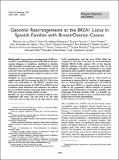Por favor, use este identificador para citar o enlazar a este item:
http://hdl.handle.net/10261/55513COMPARTIR / EXPORTAR:
 SHARE SHARE
 CORE
BASE CORE
BASE
|
|
| Visualizar otros formatos: MARC | Dublin Core | RDF | ORE | MODS | METS | DIDL | DATACITE | |

| Título: | Genomic rearrangements at the BRCA1 locus in Spanish families with breast/ovarian cancer |
Autor: | Hoya, Miguel de la; Velasco, Eladio CSIC ORCID ; Osorio, Ana; Esteban Cardeñosa, Eva CSIC; Miner, Cristina CSIC | Fecha de publicación: | ago-2006 | Editor: | American Association for Clinical Chemistry | Citación: | Clinical Chemistry 52(8): 1480-1485 (2006) | Resumen: | [Background]: Large genomic rearrangements (LGRs) account for a substantial proportion of the BRCA1 disease-causing changes, or variations, identified in families with hereditary breast/ovarian cancer [HB(O)C]. Great differences in the spectrum and prevalence of BRCA1 LGR have been observed among populations. Here we report the first comprehensive analysis of BRCA1 LGRs conducted in Spain. [Methods]: We used multiplex ligation-dependent probe amplification (MLPA) to screen for BRCA1 LGRs in the index case individuals of 384 HB(O)C families who previously tested negative for BRCA1 and BRCA2 point variations, small insertions, and deletions. An alternative set of MLPA probes, long-range PCR, and real-time PCR were used to confirm positive results. [Results]: We have identified 8 different BRCA1 rearrangements (del exon 1–24, del exon 8–13, del exon 11–15, del exon 14, dup exon 19–20, dup exon 20, exon 21–22 amplification, and del exon 23–24). With the exception of del exon 8–13, they are novel alterations. Overall, BRCA1 LGRs explain 1.4% of the Spanish HB(O)C families, and they account for 8.2% of all BRCA1 pathogenic variations identified in our study population. BRCA1 genetic variants affecting hybridization of commercially available MLPA probes are very rare in our population. [Conclusions]: Screening for BRCA1 LGRs should be mandatory in Spanish HB(O)C families. A high proportion of country-specific rearrangements are scattered along the gene. MLPA is a robust method to screen for LGRs in our population. MLPA analysis of positive samples with an alternative set of probes, together with long-range PCR and real-time PCR, is a feasible approach to confirm results in cases in which LGR breakpoints have not been characterized. | Descripción: | 6 páginas, 2 tablas.-- et al. | Versión del editor: | http://dx.doi.org/10.1373/clinchem.2006.070110 | URI: | http://hdl.handle.net/10261/55513 | DOI: | 10.1373/clinchem.2006.070110 | ISSN: | 0009-9147 | E-ISSN: | 1530-8561 |
| Aparece en las colecciones: | (IBGM) Artículos |
Ficheros en este ítem:
| Fichero | Descripción | Tamaño | Formato | |
|---|---|---|---|---|
| Genomic Rearrangementsl.pdf | 95,28 kB | Adobe PDF |  Visualizar/Abrir |
CORE Recommender
SCOPUSTM
Citations
62
checked on 21-abr-2024
WEB OF SCIENCETM
Citations
57
checked on 25-feb-2024
Page view(s)
476
checked on 23-abr-2024
Download(s)
467
checked on 23-abr-2024
Google ScholarTM
Check
Altmetric
Altmetric
NOTA: Los ítems de Digital.CSIC están protegidos por copyright, con todos los derechos reservados, a menos que se indique lo contrario.
